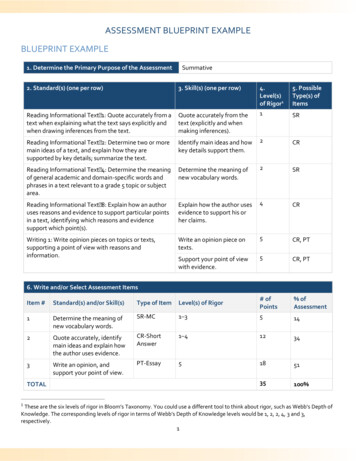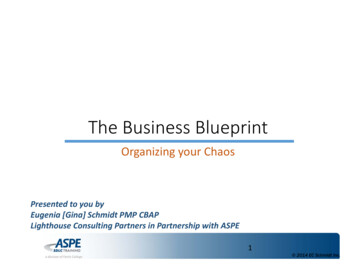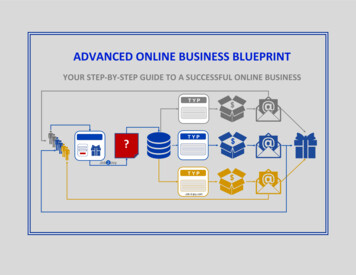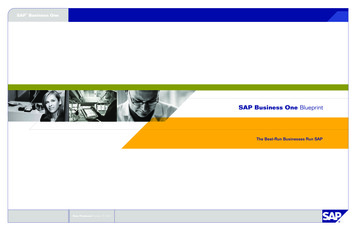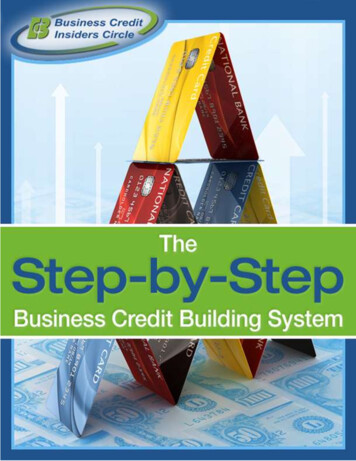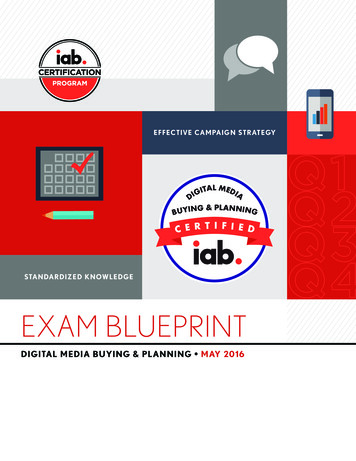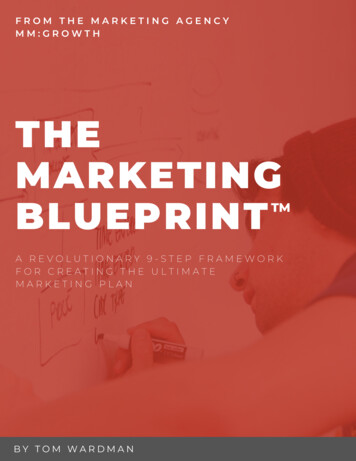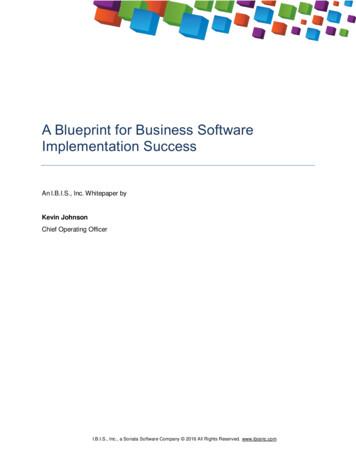
Transcription
A Blueprint for Business SoftwareImplementation SuccessAn I.B.I.S., Inc. Whitepaper byKevin JohnsonChief Operating OfficerI.B.I.S., Inc., a Sonata Software Company 2016 All Rights Reserved. www.ibisinc.com
Table of ContentsTable of Contents2Executive Summary1Objectives1A Proven Road Map for Success2Blueprint 10 Step Process3Step 1: Outline Business Requirements3Step 2: Set Priorities and Key Objectives4Step 3: Identify Risk Factors5Step 4: Map Business Process Workflows7Step 5: Assess Business Impact7Step 6: Identify Resources and Capabilities8Step 7: Match Scope to Budget8Step 8: Define Specific and Measurable Success Criteria9Step 9: Identify Key Elements of an Effective Implementation Plan10Step 10: Determine Roles and Responsibilities10How to Get Started11About the Author12About I.B.I.S., Inc.13About Advanced Supply Chain Software 13
Executive SummaryEmbarking on a new business or technology initiative can be a daunting and overwhelmingexperience. The I.B.I.S., Inc. Blueprint helps organizations minimize the risk involved withthese initiatives and gain maximum value from their enterprise software investmentwhether it is Enterprise Resource Planning (ERP), Client Relationship Management(CRM), Supply Chain Management (SCM) or Business Intelligence (BI). Blueprintsessions are designed to help business leaders gain a clear understanding of theirbusiness challenges and the potential impact of a new business software implementationon their strategic plans and business processes.During the Blueprint session, experts will collaborate with client teams to define theirbusiness requirements, and help them identify how business software solutions can becustomized to fit their business processes – not the other way around. But mostimportantly, the end result of a Blueprint is a set of recommendations that support optimalbusiness growth and help to ensure you become more productive, collaborate better, andwork smarter from day one of your implementation.ObjectivesThe primary objectives of a Blueprint session are: Identify true business requirements to set priorities and critical success factors Develop recommendations for an implementation plan including scope, tasks,resources and budget Create a risk assessment and mitigation plan Find business process workflowopportunities for process changesimprovementsandrecommending Clarify organizational roles and responsibilities within the new solution Create a unique set of Best Practices for you1
A Proven Road Map for SuccessIn Gartner Group’s recent report, ERP Strategy: Ten Steps to Perfect ERP Plans, ERPstrategy experts, Carol Hardcastle and Nigel Montgomery write:“For business leaders to achieve and recognize value from ERP, acomprehensive well-defined and well-organized approach is necessary.This starts with the development of an ERP strategy that has identified thebusiness need.”Just as Gartner outlines in their ERP Life Cycle flow chart, the starting point of anysuccessful IT initiative is outlining the strategy and developing a plan:Strategizeand PlanOperate andEvolveDeployArchitectSelectFigure 1 The ERP Life Cycle (Source: Gartner, March 2014)With the Blueprint process, Accelerated Implementation MethodologySM (AIM) isleveraged. AIM was built on Microsoft’s Sure Step methodology and designed to providethe structure and precision required for implementation success.The remainder of this whitepaper outlines and explains Blueprint’s 10 Step Process forsuccessfully planning an enterprise business software implementation.2
Blueprint 10 Step ProcessThe 10-Step Blueprint process is:1. Outline strategic business and technical requirements2. Set priorities and key objectives for the organization based on strategic andeconomic impact3. Identify potential risk factors / create a risk mitigation plan4. Map out business process workflows and areas for improvement5. Assess the potential business impact of the new system6. Inventory available resources and capabilities7. Match project scope to available budget8. Define specific, measurable success criteria9. Consult on the key elements of an effective implementation plan and map theseelements to the organization10. Recommend roles and responsibilities within the new solutionWe’ll expand on each of these steps in the following sections.Step 1: Outline Business RequirementsBefore planning any successful implementation, it is imperative to have a strategic vision.The captain of a ship must know the desired destination before charting a course. Thesame is true when planning a software implementation. Only after defining the strategycan you begin to gather the business and technical requirements for the project.When your team comes to agreement on the strategy, it is time to gather business andtechnical requirements. Requirements are a set of business needs that justify investing inthe new solution and determine the scope of the project.3
Here are some key efforts of the requirements gathering process: Identifying key business drivers and the capabilities that will be critical for successin these areas Mapping the required capabilities to current business processes and identifyingthe gaps Surveying the managers responsible for each business area and discovering theirkey pain points Summarizing the gaps in the current workflows and defining the desired processes Iterating with senior management as the requirements list is compiledThese efforts are just a few that typically occur at this step of the Blueprint session. Wewill have a much more thorough discussion about where your company is today, whereyou want it to be, and what you need to take it there.Step 2: Set Priorities and Key ObjectivesThe next step is to set the priorities and key objectives. Setting priorities based on strategicor economic impact ensures that the system is optimized for the most important businessprocesses and shortens the implementation time.There are many ways to evaluate the impact and value of business processes across thecompany. The chart below is just one example of how to structure the evaluation, providedby Gartner Group.During this step, experts collaborate with you to determine the approach that works bestfor your business.4
Business StrategyERP StrategyInventory and AssessDescribe TargetNeeds, Constraints andAccountabilities1 Inventory As-Is3 Target Business6 Capabilities andModelResources2 Opportunities and4 Key Scenarios7 Assess Budget5 Business8 EstablishAccountabilitiesRiskOutcomes10 Cross Check9 Develop PlansFigure 2 Business Process Evaluation (Source: Gartner, 2010)Step 3: Identify Risk FactorsIn this step, potential risk factors are identified that could have an impact on the successof the implementation. The experts will supplement this effort with a formal risk evaluationthat is conducted in a number of ways. Rather than adhering to a one-size-fits-allapproach, experts work with you to choose the method that works best for their business.Depending on a number of factors, here are some typical recommendations: Surveying functional or business unit managers regarding risks in their areas Conducting workshops with stakeholders to identify the broader company riskissues and how they may interact with the new system One-on-one interviews with various stakeholders.5
ure 3 Project Risk Management Process (Source: Project Management Professionals, 2012)When evaluating potential risks, it is important to consider the following: Functional areas with consistently poor performance, as these will requireadditional effort Challenges beyond the implementation, such as personnel changes or lack ofoversight Organizational readiness and change management issuesAt the end this step, you will have a high-level risk mitigation plan and will be ready tomove forward.6
Step 4: Map Business Process WorkflowsThe focus of this step is to help review the business process workflows currently in placeand identify areas for improvement. Some of the key activities include: Mapping processes at a high level, rather than getting buried in the details Engaging all stakeholders involved in each process Thinking about how workflows play out across the entire organization, rather thanfocusing on individual departments Going through each process and sub-process step by step and comparing it to thestated business requirements Identifying specific process and technological opportunities for improvementWhen this step is complete, you will know which business process workflows will beimproved and how those improvements will impact your organization.Step 5: Assess Business ImpactWhile a majority of IT initiatives fail for a number of reasons, organizations that preparefor the change by assessing the potential impact before implementation achieve a muchhigher rate of success. This step is focused on anticipating the impact of a new system onthe organization – as a whole – and sharing knowledge about what helps avoid commonimplementation pitfalls, including: Don’t start too late! Prepare the company for change as early in the process aspossible Invest in training to speed adoption of the new system Lock in executive sponsorship and involvement throughout the project life cycle Formalize and brand the project and identify a project team to promote team spirit Engage employees before the system is rolled out and make them part of thetransformation Create a communication plan for the project to address the questions andconcerns across the enterprise7
Put the “What’s in it for me?” front and center, as this is the first question mostemployees have about any projectWith the business impact clear and everyone on board with the changes, the project isassured of far greater success.Step 6: Identify Resources and CapabilitiesThis step reveals where there are gaps in skills, experience, and resources needed tomake the project successful. During this step, experts will work with you to systematicallyidentify the capabilities within the organization and those that need to be developed,supplemented, or completely outsourced. Some of the key areas to be explored duringthis phase of the Blueprint process include: Understanding whether internal resources have the necessary domain expertise Learning whether team members have the required operational and processknowledge Discovering what technical capabilities are available internally and where there areskills that are more or less mature Finding out whether your team is familiar with the new software and whether theirskills need to be further developed Identifying qualified candidates for key roles, such as executive sponsors, projectmanagers, data analysts, technical leads, etc. Understanding what new capabilities you need within the new system and how toallocate the time for those individuals to get up to speed and work on the projectAt the end of this step, your team will have a far better idea of where resources are limitedand can develop plans to fill in the gaps.Step 7: Match Scope to BudgetWhen scoping an implementation project, it is important to understand the business’operating budget so as to identify any potential constraints on capital and determinewhether appropriate budget will be available during the project implementation. While thebudget should never be the sole dictator of project scope, it is one of the most importantfactors for success.8
If the desired project scope is beyond what the budget can bear, experts will work withyou to find ways to match the project plan to the available budget. There are many optionsfor doing this, including developing a phased approach that allows high priority features tobe rolled out over time. Another is to include all the desired features of the solution butlaunch them based on regions or functions over subsequent phases.Either way, working together, we will create a Blueprint that is successful and works withthe available budget.Step 8: Define Specific and Measurable SuccessCriteriaLike the well-known saying goes, “what gets measured gets done”. This is no less true forany IT initiative. At this point in the Blueprint process, the desired business outcomes havebeen identified, but those outcomes have to be quantifiably measurable. For example, ifone of the desired outcomes is to streamline business processes, and the operationalversion of that outcome might be to reduce administrative effort by 10%. Other examplesof converting desired business results into tangible, measurable goals include: Increasing sales by eliminating “out of stocks” and/or eliminating allocation errors Decreasing cost of goods sold through increased visibility into cost factors such aspurchase cost, freight, storage costs, etc. Increasing cash flow through more efficient procedures, better inventory levelmanagement, and cash collections Reduce the “days to close” in accounting department by having completelyintegrated and operational general ledgersBy automating a range of manual processes, and increasing employee efficiencies whileproviding the right information for effective business intelligence and reporting, your goalscan be achieved.9
Step 9: Identify Key Elements of an EffectiveImplementation PlanJust like an architect needs a blueprint to construct a house, this Blueprint is paramountto the success of any effective business implementation. The process of identifying theright elements to include in the implementation plan involves a number of factors, andthese key questions should be asked: Is the implementation a complete or phased implementation? What is the amount of time employees can dedicate to the project? How much disruption can your business can tolerate? What is the composition and structure of the project team? Can the project can be managed in terms of a calendar timeline? What elements of the project are owned by the implementer vs. internally?At the end of this step, you will have recommendations for an impleme
At this point in the Blueprint process, the desired business outcomes have been identified, but those outcomes have to be quantifiably measurable. For example, if
